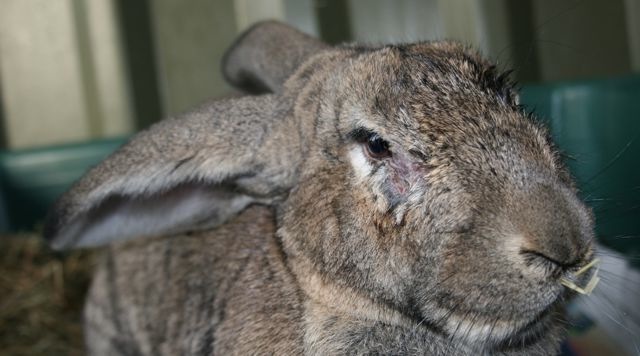WHEN DOES MY RABBIT NEED A VET?

Eye trouble. c. Celia Haddon
It’s really difficult to tell if a rabbit is ill or suffering. It’s not much use to look at its face: it won’t usually show pain or misery in its facial expression (Leach et al. 2009). Indeed rabbits often hide all signs of pain in the presence of predators (who would otherwise eat them) and this may include their owners (AHWLA 2013). They do not usually howl or whimper (Harcourt-Brown 2002) though in extremis a wild rabbit may scream. These are signs that your rabbit needs veterinary attention.
- Pain. The rabbit will be immobile, hiding all signs or pain or discomfort. If it feels confident enough to move at all, it may be twitching, wincing, staggering, flinching, arching its back, quivering or sort of shuffling (Leach et al., 2009). Sitting hunched up with legs drawn in a ‘tight huddle’ (Farnworth et al., 2011). A previously calm rabbit may be aggressive to its owner or to a companion rabbit, grind its teeth or stop eating (Harcourt-Brown 2002).
- Stops eating or shows reluctance to eat, absence of droppings or fewer in the litter tray, diarrhoea. When rabbits stop eating, it is essential they see a vet. It may be tooth trouble or some other illness. If the whole gut stops moving, it is a veterinary emergency.
- Drooling, wet chin or dewlap. These are often signs of tooth trouble.
- Runny eyes, swollen eyes or face, bulging eye. Runny eyes are sometimes a sign of tooth trouble, otherwise these are signs of eye trouble or illness like myxomatosis.
- Sneezing, dripping nose, noisy breathing. This could be a foreign body, teeth/eye problems or a respiratory infection, ‘snuffles’ or pasteurella.
- Ear shaking, scratching at ears, sore ears. This could be ear mites.
- Head tilted to one side. The head tilt can be due to snuffles or sometimes to a brain parasite E. cuniculi,.
- Teeth grinding, urinates outside the litter tray, urine stained back legs. Rabbits are prone to urinary stones because of the way their body handles calcium.
- Limping, poor balance, immobility, cecotrophs sticking to bottom, unkempt fur round backside. All these may be signs of arthritis. The rabbit can no longer turn round to groom itself at the back or to eat its cecotrophs from the bottom.
- Abcesses, fly strike, wounds. These all need veterinary attention.
- Incontinence or loss of litter tray training. This can be E. cuniculi or other diseases.
- Sore hocks or just the beginning of sore patches. Older fatter females are likely to get this. Check regularly.
REFERENCES
AHWLA (2013), “What about other species?’ Assessing the Health and Welfare of Laboratory Animals. Available at www.ahwla.org.uk/site/tutorials/RP/RP10-Other2.html Accessed February 27 2013.
Farnworth, M. J., Walker, J. K., Schweizer, K. A., Chuang, C-L., Guild, S-J., Barret, C.J., Leach, M. C. & Waran N. K., (2011), ‘Potential behavioural indicators of post-operative pain in male laboratory rabbits following abdominal surgery,’ Animal Welfare, 20, 225-237.
Harcourt-Brown, F., (2002), Textbook of Rabbit Medicine, Oxford, UK, Butterworth-Heinemann.
Leach, M. C. Allweiler, S., Richardson, C., Roughan, J. V., Narbe, R. & Flecknell, P. A., (2009), ‘Behavioural effects of ovariohysterectomy and oral administration of meloxicam in laboratory housed rabbit,’ Research in Veterinary Science, 87, 336-347 Abstract Only.
Mancinelli, E., Keeble, E., Richardson, J. & Hedley, J., (2014), ‘Husbandry rusk factors associated with hock pododermatitis in UK pet rabbits (Orcolagus cuniculus)‘, Veterinary Record, 174, 429